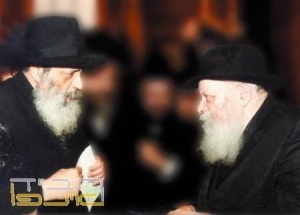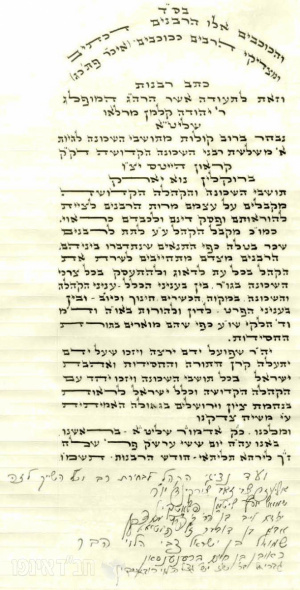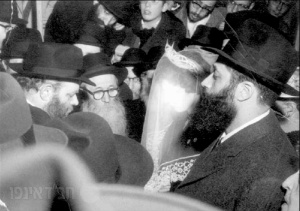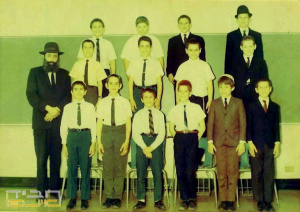Yehuda Kalman Marlow

Rabbi Yehuda Kalman Marlow (10 Adar I 5692 - 20 Sivan 5760) was the rabbi of the Crown Heights neighborhood in Brooklyn, and one of the prominent leaders who believed in the Rebbe as Melech HaMoshiach even after 3 Tammuz 5754. He was called by the Rebbe "Knight of Knights."
Life History
Rabbi Yehuda Kalman Marlow was born on 10 Adar I 5692 in Frankfurt am Main, Germany, to his father R' Avraham Yehoshua Malinowski, who was the son of R' Baruch Kalman Malinowski who gave lectures in Rabbi Breuer's beit midrash, and to his mother Mrs. Rachel who was descended from a famous rabbinical dynasty beginning with Rabbi Heschel, head of the rabbinical court of Krakow (about whom the Chida wrote that "many rabbis and scholars came from his loins, holy ones who are in the land of life, and may the living be distinguished, the rabbinical scholars of the generation, his honored ones and relatives - may his name be forever, so may it be"). Her father was R' Yehuda Zelig Mischelovsky, and her mother was Mrs. Leah of the Sheinkel family.
In the United States
After the Nazi Party under Hitler's leadership rose to power, staying in Germany became unbearable, and in 5698 the family immigrated to the United States and settled in Newark, New Jersey, where they shortened their family name to Marlow.
During this period, his father preferred to work in menial and difficult jobs rather than violate the Sabbath. Hard days passed for the young six-year-old son, who sometimes even went hungry. But despite their difficult financial situation, the parents sent their young son to study at the Torah Vodaath Yeshiva. In Newark lived the Chassid R' David Stockhammer, who was the father-in-law of Rabbi Mordechai Mentlik and Rabbi Moshe Pinchas Katz. The conduct of these Chassidim influenced Yehuda Kalman to go study at Tomchei Tmimim. This was also when the first connection with Chabad Chassidut was formed through Rabbi Shalom Dovber Gordon, a young Chabad man who had immigrated to the United States a few years earlier with his father, the Chassid R' Yochanan Gordon, and began spreading Chassidic teachings in Jewish educational institutions.
His father, R' Avraham Yehoshua, despite not being among the Chassidic community, greatly admired the Chassidic ways, and when the Rayatz (Previous Rebbe) arrived in the United States, he traveled together with the Chassidim to the Rebbe's farbrengen.
Over the years, R' Avraham Yehoshua participated several times in the Rayatz's farbrengens, and even had private audiences with the Rebbe twice. Sometimes he brought his son, who was already a young man, to absorb the Chassidic atmosphere in the Rebbe's court. Since young students were not allowed to participate in farbrengens, young Yehuda Kalman had to hide during the gatherings. When he reached bar mitzvah age, his father wanted to bring him for a private audience, but during that period the Rayatz was ill and only a few were permitted to enter for yechidut (private audience).
On Shabbat Kodesh 10 Shevat 5710, he was in Newark when he received news of the Rayatz's passing. He hurried to Beit Chayeinu and participated in the large funeral that took place the next day.
In Tomchei Tmimim
In the period following the Rayatz's passing, he went to study at the Tomchei Tmimim Yeshiva in New York, and would occasionally come to our holy courts and participate in the Rebbe's farbrengens.
One year, when he entered for yechidut on his birthday, the Rebbe asked him which tractate he was studying. After he replied that he was studying Tractate Gittin, which was being learned that year in the yeshiva's schedule, the Rebbe asked him how he studied it. When he replied that he studied the Gemara with Rashi's commentary, Tosafot and commentaries - the Rebbe asked "What about the poskim (Jewish law authorities)?" From that yechidut onward, he began placing special emphasis on studying the legal rulings related to the tractate being learned in the yeshiva.
During those years, Rabbi Marlow studied at the Central Tomchei Tmimim Yeshiva at 770. At a young age, he already received rabbinical ordination from the heads of the Central Tomchei Tmimim Yeshiva.
During the last day of Passover 5718, the Rebbe addressed him by his private name, asked if he had drunk the four cups, and poured for him from the wine pitcher on his holy table.
His Wedding
On 4 Adar 5719, he married Mrs. Chaya of the Reicher family, with the Rebbe officiating at the wedding ceremony. His wife's mother was murdered by the Nazis in the death camps in Europe, and his wife miraculously survived and immigrated to the United States, where she was taken in by the Baker family.
After the wedding, Rabbi Marlow worked as an educator at the Lubavitcher Yeshiva and became a beloved teacher. Even when the burden of making a living fell upon him, he never stopped studying Torah for a moment. In the morning hours, he would teach at the yeshiva, and after classes ended, he would go to the synagogue and sit down to study with diligence and persistence. Only in the late night hours would he return home.
At that time, Rabbi Zalman Shimon Dvorkin served as the rabbi of Crown Heights, speaking mainly in Yiddish and not having a good command of English. Baalei teshuva (newly religious Jews) who joined the community and spoke only English could not communicate with the community's rabbi and preferred to ask Rabbi Marlow, who was fluent in English. Rabbi Marlow, who did not want to rule on Jewish law in front of his rabbi, would not respond directly to questioners but would open the Shulchan Aruch to the relevant section and study it with them until they understood what the Shulchan Aruch ruled in such a case.
Every year he would complete several tractates in depth, and before each holiday, he would thoroughly review all the laws related to that holiday. He also had a special study schedule for learning the laws applicable throughout the year. He knew the entire Torah with Rashi's commentary and Targum Onkelos by heart, and was a very precise Torah reader. The cantillation marks were fluent on his tongue.
In 5737, N'shei Chabad published a cookbook, and Rabbi Marlow was responsible for the halachic aspects of the book. When Rabbi Marlow presented the book to the Rebbe at one of the farbrengens, the Rebbe told him: "Enough of being hidden away. It's time for you to become a halachic authority for the public!"
The Rebbe once also referred to him as an "ish halacha" (man of Jewish law).
The Incident in the Sukkah of 770
During Sukkot 5730, during the Rebbe's farbrengen in the sukkah of 770, the Rebbe strongly encouraged the singing and the large crowd danced in place with great enthusiasm. Due to the intensity of the dancing, one of the pyramids collapsed and crushed Rabbi Marlow's leg. Despite the tremendous pain, the Rabbi restrained himself and did not utter a sound, so as not to disturb the farbrengen. The organizing committee rushed to the scene and began clearing away the attendees, trying to move the Rabbi who had meanwhile laid down on the floor, but then they noticed his crushed leg under the pyramid boards. Meanwhile, the singing stopped, the Rebbe's face became serious, and he watched the scene continuously.
After much effort, they managed to extract the Rabbi, and he was rushed to the hospital, where he was immediately admitted and received emergency treatment. His leg was in a cast for six months, and it is said that the Rebbe was involved in all the different stages of treatment.
On the evening after Simchat Torah that year, two of his friends went to the hospital and brought him on crutches to the Rebbe's ongoing farbrengen. When they entered, the Rebbe was in the middle of a talk, and the Rabbi asked to be placed on the side so as not to cause unnecessary attention. When the talk ended, the Rebbe looked in his direction and instructed that he be brought up to the farbrengen platform and be given 'l'chaim'.
Elections for Crown Heights Rabbinate
On Saturday night, 17 Adar 5745, Rabbi Zalman Shimon Dvorkin, the rabbi of Crown Heights, passed away. Just over a year later, elections were held in which the neighborhood residents chose three rabbis: Rabbi Yehuda Kalman Marlow (who for many years was a member of the Lubavitch rabbinical court headed by Rabbi Dvorkin), Rabbi David Chanzin, and Rabbi Avraham Azdaba. Rabbi Marlow was elected by a majority of over eight hundred out of a thousand eligible voters. Since the Rebbe instructed Rabbi Chanzin to remain in the Holy Land, additional elections were held in which Rabbi Yosef Avraham Heller was elected as the third rabbi.
The process of selecting the rabbis was accompanied by the Rebbe's personal involvement, and when certain activists tried to interfere with the election process, the Rebbe expressed himself in extraordinary language:
"When I saw the state of affairs - I had no choice but to turn away from all my affairs and put them aside, and ensure that the entire matter of electing and appointing rabbis would be conducted according to the Shulchan Aruch."
In another talk, the Rebbe applied to the neighborhood rabbis the saying of our Sages:
"Yerubal in his generation is like Moses in his generation... Yiftach in his generation is like Samuel in his generation... When one is appointed as a leader over the public, he is like the mightiest of the mighty... You must only go to the judge who is in your days."
Persecutions
Over the years, there were individuals who harassed Rabbi Marlow, among other things because of the cases he presided over: the Rebbe's will, the Weinstock will, Chayalei HaMelech, and more. During the discussions about the Weinstock will, there were those who worked to have the "Rabbinical Association" issue a 'refusal' against the Rabbi. Rabbi Marlow, as was his way, maintained his composure, but this conduct caused him great distress.
Spreading the Message of Redemption
Rabbi Marlow had a special enthusiasm for all matters concerning redemption and Moshiach, particularly regarding the identity of King Moshiach. The Rabbi used every opportunity to encourage activity in these areas, and he himself participated in these activities.

In 5747, after the entire congregation cried out "Ad Mosai!?" (Until when!?) during the Rebbe's farbrengen on Shabbat Parshat Vayigash, and there was a special awakening regarding matters of redemption, twenty-five rabbis headed by Rabbi Marlow sat for a special discussion on the topic and issued a ruling stating that according to the Torah of truth, God must bring the redemption immediately. The next day, on the tenth of Tevet before Mincha prayer, Rabbi Marlow presented the ruling to the Rebbe.
Similarly, in the summer of 5751, when the rabbinical rulings that the time of redemption had arrived and that the Rebbe is King Moshiach were being considered, Rabbi Marlow was one of the most dominant forces in the matter.
Even after 3 Tammuz 5754, he continued to encourage all those involved in spreading the message of redemption and the redeemer.
Once, members of the "World Headquarters for Saving the Nation and the Land" asked the rabbis of the Crown Heights Beit Din to write a public letter calling for action regarding the completeness and salvation of the Land of Israel. They also wanted other rabbis to join and sign but worried that if the title "King Moshiach" was written for the Rebbe, other rabbis wouldn't sign. Rabbi Marlow immediately responded that if the title "King Moshiach" wasn't included for the Rebbe, then he wouldn't be able to sign it!
On 2 Nissan 5755, he traveled to the Holy Land for the first time in his life to participate in the Revava conference held at Yad Eliyahu in Tel Aviv. His speech lasted only three minutes, but no more was needed. The words spoke for themselves:
"All the rabbis and gathered people assembled here tonight to strengthen the faith in Moshiach and that Moshiach is with us. I have merited to represent the Crown Heights community - 'here God commanded the blessing,' where all people are here in spirit, and participate together with all those gathered in 'the land which the eyes of the Lord your God are upon from the beginning of the year to the end of the year,' and to represent all those who proclaim and cry out 'until when.'"
"It's important to note that today, ten months have already passed in which we are in a situation that further emphasizes the cry of 'until when,' and the main thing is that we end with good - today marks seven complete years since the Rebbe informed us about the proclamation of 'Yechi.' I represent, as mentioned, the Crown Heights community who proclaim this declaration here in the Holy Land: Yechi Adoneinu Moreinu v'Rabbeinu Melech HaMoshiach L'olam Va'ed."
The Rabbi's last public appearance was at the Jubilee conference organized by the World Chabad Center for Greeting Moshiach on the eve of 10 Shevat 5760. He spoke about the importance of pure faith in small children: "Unfortunately, today's children have never seen the Rebbe, and despite everything, they grow up as true mekusharim (connected ones) and believe with complete faith. Fine, we - we saw the Rebbe. But from where do they have these powers? It must be that these are very high souls, with most elevated powers. Otherwise, there is no explanation."
[[
|thumb]]
His strong faith in the Rebbe as King Moshiach was also expressed during his illness when doctors ordered him to be confined to his bed. On the first Shabbat after his surgery, while he was in the hospital, ten students from the Central Tomchei Tmimim Yeshiva at 770 came to pray Kabbalat Shabbat with the Rabbi in a minyan. Before they began praying, family members asked them to hurry the prayer somewhat, due to the Rabbi's condition. When they reached the end of "Lecha Dodi," the Rabbi signaled with his hand for them to do a 'Yechi' dance. When he noticed their hesitation, he rose from his chair and began dancing himself and singing 'Yechi Adoneinu.' The dancing continued for ten minutes, after which he returned to his bed completely exhausted. The effort was so great that after the prayer, the Rabbi was unable to make Kiddush and had to rest for two full hours. After he woke up, he told his family that this was a special prayer, and afterward made Kiddush.

It should be noted that Rabbi Marlow was among the Chabad rabbis who issued a Torah ruling that it is forbidden to write titles implying the opposite of life about the Rebbe.
His Passing
After Tishrei 5760, the Rabbi felt strange fatigue. Initially, he thought it was accumulated tiredness, but after several weeks he realized it was something much more serious. He went for medical tests, where it was discovered that he had a cancerous tumor spreading near his brain. A surgery date was immediately set to remove the tumor.

The surgery was scheduled for 7 Kislev. The night before surgery, the Rabbi was hospitalized for medical monitoring. He used that night to study the Turei Zahav on the laws of Chanukah in depth. He was so immersed in his studies that he didn't even notice his son-in-law Rabbi Schechter entering and leaving the room every half hour.

After the first surgery, when he returned to the hospital, he wrote a letter to the Rebbe and inserted it into the Igrot Kodesh. In his letter, the Rabbi asked for a blessing that he would not become a burden on his family members during his illness.

Indeed, his condition began to stabilize. Two months later, the illness attacked him again, this time much more severely, and he became bedridden. His last public appearance was on the eve of 10 Shevat 5760 (at an event celebrating fifty years of the Rebbe's leadership at 'Ohalei Torah' hall, where he gave an especially long speech of about forty-five minutes). After 10 Shevat, he could no longer leave his home, and the Temimim (yeshiva students) would organize minyanim in his house. From then on, the Rabbi's condition did not improve, and for eight months he suffered prolonged afflictions. The name 'Chaim' was added to his name.
In the final months of his illness, the Anash community worldwide, especially the Crown Heights Anash community, increased their prayers for his recovery, and following the suggestion of Beis Din member Rabbi Avraham osdaba, they added study of the laws of Shabbat in his merit.
On Thursday night, 20 Sivan 5760, he went to the hospital for medical treatment. During treatment, a few minutes after midnight on Friday morning, the Rabbi suffered a heart attack from which he did not recover.
The Funeral
Even before he was transferred to the 'Shomrei Hadas' funeral home in Borough Park, groups of students from the Central Tomchei Tmimim Yeshiva at 770 came to the hospital to recite Tehillim until the time of the funeral.
At 8:00 AM, an alarm pierced the air of Crown Heights (the first time since the night after Shabbat, 3 Tammuz 5754). Neighborhood residents, awakening to hear the news, began streaming toward 770. The mikvahs throughout the neighborhood immediately filled with crowds of Chassidim preparing for the funeral procession.
Throughout Crown Heights and other Jewish neighborhoods in Brooklyn, notices of mourning were posted by the Crown Heights Community Council announcing the time of the funeral. New York media outlets also continuously reported in their news broadcasts about the passing of 'the Chief Rabbi of Chabad Center in New York.'
At 10:00 AM, as the funeral procession was about to leave the funeral home in Borough Park, the alarm sounded again throughout Crown Heights, and all stores in the neighborhood, including non-Jewish owned ones, ceased operations.
Thousands of men, women, and children gathered on Eastern Parkway, opposite 770. Adjacent streets were closed to vehicle traffic. Many journalists and media personnel gathered in a special area with mobile broadcasting units to cover the funeral procession.
Around 10:40 AM, the Chevra Kadisha vehicle arrived, accompanied by three police cars and several police motorcycles, in front of 770. As soon as the Chevra Kadisha vehicle stopped, a long line of people began to walk past the coffin to ask for forgiveness.
After thousands had passed by the coffin, the Chevra Kadisha vehicle began moving slowly along Eastern Parkway, with thousands walking in pain and silence behind the coffin. Leading the funeral procession were the Crown Heights Beit Din members, the Gaonic Rabbis Avraham Azdaba and Yosef Avraham Heller, and all the heads of Chabad institutions.
Afterward, a procession of dozens of cars began moving slowly toward the Chabad Chassidim cemetery in New York, arriving after a long hour. Before the burial, Rabbi Shneur Zalman Gurary stood by the open grave and with emotional words addressed the deceased Rabbi, commanding him to go before the Rebbe and demand, through the power of the holy Torah, that God must bring the true and complete redemption with the revelation of the Rebbe King Moshiach immediately.
The Beit Din secretary, Rabbi Levi Yitzchak Shapiro, requested on behalf of the entire community to arouse heavenly mercy for the neighborhood residents and bring the complete redemption. Afterward, the entire congregation said "Yechi Adoneinu" three times.
Rabbi Yehuda Kalman Marlow was buried in the Kohanim row in the Chabad section, near the holy Ohel.
Customs and Stringencies
- Never missed even one day of Chitas and Rambam studies since the establishment of the holy regulation (even in his final days)
- Insisted on not letting a day pass without immersion in the mikvah
- Had several pairs of tefillin and was careful to check them every 12 months (not necessarily in Elul)
- Was careful not to drink water that had been in metal vessels, even in cases where all authorities agree there is no issue
- After prayers on Shabbat nights, would place two tallit bags full of books on the table, which he would study in a certain order, usually until 11 PM. Only then would he return home for the Shabbat meal
- Would not dry himself on Shabbat, concerned about squeezing (therefore would sit and study in the synagogue above the mikvah until his hair dried)
- On Shabbat Mevorchim, would not go to bed at all. After the meal, would doze in his chair for two hours, then get up, wash his hands, and after morning blessings would begin saying Tehillim
- Would usually complete Tehillim twice on Shabbat Mevorchim
- Completed several tractates in depth each year
- On Erev Pesach - being a firstborn - would conduct a siyum masechet and was careful to fast on that day
- Would read the Haggadah with special pleasantness and sweetness, carefully enunciating each word
- Did not sleep in a bed during all days of Sukkot (from the start of the first holiday until after Simchat Torah)
- Whenever traveling at night, would ask to stop immediately at sunrise to put on tefillin and recite Shema
- Was careful not to eat outside the home (even coffee)
- Was a great philanthropist and was careful to give charity secretly
- Did not want to accept favors from people
His Family
- His wife, Rebbetzin Chaya Marlow
- His son, Rabbi Yosef Yitzchak Marlow - emissary and rabbi at 'Beit Menachem' synagogue in N. Miami Beach, Florida
- His daughter Mrs. Rivka Schechter, wife of Rabbi Yosef Ben Zion Schechter
- His daughter Mrs. Leah Glikel Shmukler, wife of Rabbi Meir Eliezer Shmukler
Activities in His Memory
- Mivtza Shoneh Halachos - Each year, hundreds of children from Ohalei Torah and Lubavitcher Yeshiva institutions memorize dozens of sections in Kitzur Shulchan Aruch with the Alter Rebbe's rulings and are tested on the laws. At the end of the campaign, a quiz is held between students of the institutions, attended by students' parents and Crown Heights residents. A number of judges examine the participants to determine which children will advance and win prizes.
- Yehuda Kalman Evening Yeshiva - Each year, children from educational institutions in Crown Heights participate in evening yeshiva programs throughout the year, receiving holy books and book purchase vouchers for religious bookstores.
- Tiferet Yehuda Kalman - For the first yahrzeit of Rabbi Marlow (20 Sivan 5761), a "Memorial Book - Tiferet Yehuda Kalman" was published in his honor and memory. It included teachings from our Rebbes, first Chassidim, scholarly discussions from rabbis worldwide, and a brief history of the Beis Din and Rabbi Marlow's life. For the second yahrzeit (20 Sivan 5762), a second volume was published.
- Eshel - Hachnosas Orchim - A guest house (near the corner of Eastern Parkway and Kingston, more precisely: 272 Kingston Street) containing dozens of spacious and well-equipped bedrooms for guests coming to stay in 'our holy courts' throughout the year.
- Torah Scroll - Writing of a Torah scroll in memory of Rabbi Marlow.